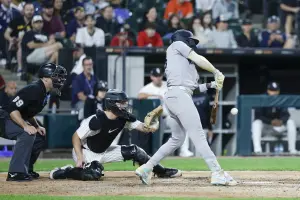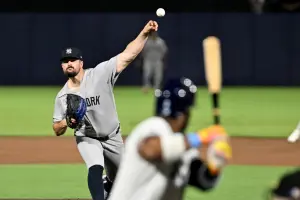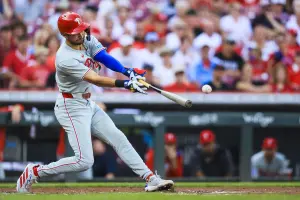
(*) F/F SPOTLIGHT: Brandon McCarthy
Bring up the name of Brandon McCarthy (RHP, ARI) in your league and you're likely to hear one of crickets, indifference, or shouting.
After all, he has topped 140 IP just once in his career due to a history of arm problems.
At age 30, he's not young enough to be on an intriguing growth curve.
And very few owners would take the risk of rostering a guy with a history of spending more time on the DL than in an MLB rotation, not to mention one who has a 1-10 record and a 5+ ERA.
Even skill-savvy owners roll their eyes when his name is mentioned. He's compared to guys like Joe Blanton and Dave Bush, pitchers who repeatedly showed great command but would torpedo your staff due to their HR-fueled blowups.
Let's take a closer look at McCarthy to see if there may be reasons for optimism in the face of all this pessimism.
Background
McCarthy's career has been marked by poor durability and only one season of strong skills:
Year IP | ERA WHIP | Ctl Dom HR/9 GB% BPV ==== === | ==== ==== | === === ==== === === 2005 67 | 4.03 1.18 | 2.3 6.4 1.7 35% 67 2006 85 | 4.68 1.30 | 3.5 7.3 1.8 38% 53 2007 102 | 4.87 1.56 | 4.2 5.2 0.8 36% -7 2008 22 | 4.09 1.27 | 3.3 4.1 1.2 24% -13 2009 97 | 4.62 1.36 | 3.3 6.0 1.2 39% 35 2010 ---------------------Injured--------------- 2011 171 | 3.32 1.13 | 1.3 6.5 0.6 47% 106 2012 111 | 3.24 1.25 | 1.9 5.9 0.8 41% 73 2013 135 | 4.53 1.35 | 1.4 5.1 0.9 48% 79
He made some adjustments after missing the entire 2010 season with shoulder problems.
First, he started to display pinpoint control, an improvement that has been supported by a sustained jump in his rate of first-pitch strikes (FpK%) over the last two seasons:
Year Ctl FpK% ==== === ==== 2005 2.3 60% 2006 3.5 54% 2007 4.2 53% 2008 3.3 68% 2009 3.3 61% 2010 --------- 2011 1.3 61% 2012 1.9 67% 2013 1.4 68%
Our research on first-pitch strike rates has shown that pitchers often hold on to significant gains in their FpK%, an assertion that McCarthy has proven true to a large extent.
In addition, McCarthy has become a groundball pitcher in recent years. After never posting a 40%+ groundball rate in his first five seasons, he has put up a near-50% GB% in two of the last three seasons:
Year HR/9 GB% ==== ==== === 2005 1.7 35% 2006 1.8 38% 2007 0.8 36% 2008 1.2 24% 2009 1.2 39% 2010 -------- 2011 0.6 47% 2012 0.8 41% 2013 0.9 48%
It's a profile switch that has paid immediate dividends. After struggling to keep the ball in the park early in his career, his HR rate has been below average the last three seasons.
2014 Results
After spending most of his career as a below replacement-level performer, McCarthy's apparent value has dropped even lower so far this season:
Year W-L ERA WHIP RAR R$ 5x5 ==== ==== ==== ==== === ==== === 2014 1-10 5.38 1.39 -19 $-15 $-9
That said, McCarthy is displaying better skills in 2014 than at any other season in his career:
Year IP | ERA WHIP | Ctl Dom HR/9 GB% BPV ==== === | ==== ==== | === === ==== === === 2005 67 | 4.03 1.18 | 2.3 6.4 1.7 35% 67 2006 85 | 4.68 1.30 | 3.5 7.3 1.8 38% 53 2007 102 | 4.87 1.56 | 4.2 5.2 0.8 36% -7 2008 22 | 4.09 1.27 | 3.3 4.1 1.2 24% -13 2009 97 | 4.62 1.36 | 3.3 6.0 1.2 39% 35 2010 -------------------Injured----------------- 2011 171 | 3.32 1.13 | 1.3 6.5 0.6 47% 106 2012 111 | 3.24 1.25 | 1.9 5.9 0.8 41% 73 2013 135 | 4.53 1.35 | 1.4 5.1 0.9 48% 79 2014 97 | 5.38 1.39 | 1.7 7.4 1.4 56% 123
There are 116 starting pitchers who have at least 60 IP so far this season. Only 19 of them can claim a 120+ BPV, and most of them are rotation anchors:
Name BPV ================== === Kershaw, Clayton 222 Price, David 180 Strasburg, Stephen 172 Tanaka, Masahiro 167 Hernandez, Felix 166 Sale, Chris 164 Greinke, Zack 145 Bumgarner, Madison 142 Lee, Cliff 140 Cueto, Johnny 140 Kluber, Corey 139 Hughes, Phil 131 Iwakuma, Hisashi 128 Kennedy, Ian 127 Scherzer, Max 126 McCarthy, Brandon 122 Lester, Jon 122 Wainwright, Adam 121 Hammel, Jason 121 *min 60 IP
McCarthy's 56% GB% groundball rate is by far the highest he has shown in his career. In fact, it's the seventh-highest mark in MLB.
His poor surface stats have been driven by three indicators that are largely out of his full control:
- 35% H% (worst in career)
- 64% S% (worst in career)
- 22% hr/f (worst in career)
Just keep in mind that guys who give up a lot of HR will tend to have lower strand rates, since their baserunners have no chance of being stranded when a HR is hit.
The single biggest factor in McCarthy's high ERA has been a surge in gopheritis. It's an issue he had overcome for the last three seasons.
It's surprising that he has been plagued by the long ball at a time when he is inducing more groundballs than ever. The culprit has been an extremely high rate of HRs allowed per flyball (hr/f), a mark that is significantly higher than at any other point in his career:
Year HR/9 hr/f ==== ==== ==== 2005 1.7 15% 2006 1.8 15% 2007 0.8 6% 2008 1.2 9% 2009 1.2 10% 2010 --------- 2011 0.6 6% 2012 0.8 8% 2013 0.9 10% 2014 1.4 22%
Given the amount of groundballs that McCarthy is inducing compared to earlier in his career, even a modest reduction in his hr/f would result in his HR/9 reverting close to the levels that he has shown over the last three seasons.
- PITCHf/x Observations
McCarthy's skill gains so far in 2014 largely have been validated by their underlying indicators.
He has a 7.0+ Dom for only the second time in his career. His level of swinging strikes (SwK%) also is at the highest level it has been since 2006, the only other year that he has posted a 7.0+ Dom:
Year Dom SwK% ==== ==== ==== 2005 6.4 8% 2006 7.3 9% 2007 5.2 8% 2008 4.1 7% 2009 6.0 7% 2010 --------- 2011 6.5 8% 2012 5.9 7% 2013 5.1 6% 2014 7.4 9%
While McCarthy's FpK% isn't quite to the levels that he showed during the last two seasons, it's at a level that is strongly correlated with a Ctl (BB/9) in the low-to-mid 2s, still leaving him plenty of Cmd (K/BB) to succeed even if his Ctl deteriorates a bit:
Year Ctl FpK% ==== === ==== 2005 2.3 60% 2006 3.5 54% 2007 4.2 53% 2008 3.3 68% 2009 3.3 61% 2010 --------- 2011 1.3 61% 2012 1.9 67% 2013 1.4 68% 2014 1.7 64%
Let's try to find an explanation for why McCarthy is getting hit so hard at times.
Our analysis shows that McCarthy's gopheritis can be attributed mostly to his cutter. He has a sub-15% hr/f on the three other pitches that he throws frequently, but he has a whopping 24% hr/f on his cutter (all exhibits provided by BrooksBaseball.net):
His cutter is a pitch that he throws more for balls and less for strikes than his other three primary pitches, which certainly could contribute to hitters mashing it when it does fall over the plate:
The blowup risk of his cutter can be seen in the traditional stats that batters are putting up against it, such as batting average and slugging percentage:
While McCarthy has been able to generate swinging strikes at a good rate on his cutter (13% SwK%), batters are hammering it when they hit it. They swing at his cutter a remarkable 84% of the time when it is thrown in the strike zone, a rate that is 27% higher than the swing percentage he is getting on his sinker and 86% higher than the one he generates on his curveball. In summary, he has trouble throwing his cutter for strikes, but when he does, it's getting hammered. The location of his cutter within the strike zone has been his downfall.
There is a possible solution in McCarthy's revised toolbox that he could exploit. He has begun to use a four-seam fastball this year, and although he uses it infrequently, he's throwing it at an impressive velocity (95 mph). As you can see above, batters have managed just one extra-base hit against it the near 100 times he has thrown it. Scrapping his cutter for more four-seam fastballs could be the solution that lets McCarthy avoid the blowups that have plagued him this season.
Also, we should keep in mind that McCarthy's cutter was much more effective in 2013 (.133 ISO against it). This gives hope that McCarthy could reverse his misfortunes even without making radical changes to his pitch mix.
Conclusion
It's easy to ignore or dismiss guys like McCarthy, a fragile pitcher with rejuvenated skills but lousy stats. That said, he's an example of a guy with excellent profit potential in the second half.
A tweak in his pitch mix and likely regression of his H%, S%, and hr/f all could help him produce a sub-3.50 ERA for the balance of the season.
Before you dismiss that possibility, remember that he posted sub-3.50 ERAs in 2011 and 2012, and his skills this season are even better than they were then.
We can't expect him to be able to sustain good health for the first time now that he's in the 30s, but if you can stomach his durability risk, there's a lot to like in the new Brandon McCarthy.
There’s more where this came from to help you win your fantasy league. Check a BaseballHQ.com subscription, which gives you complete access to the site through the entire 2014 season.









